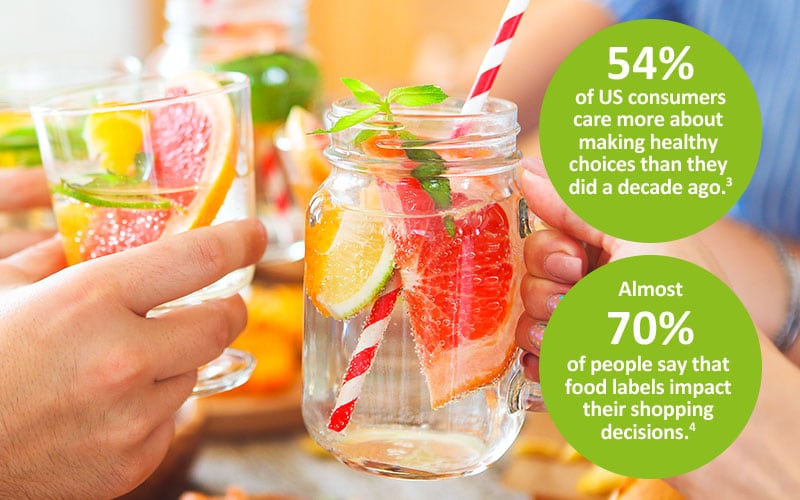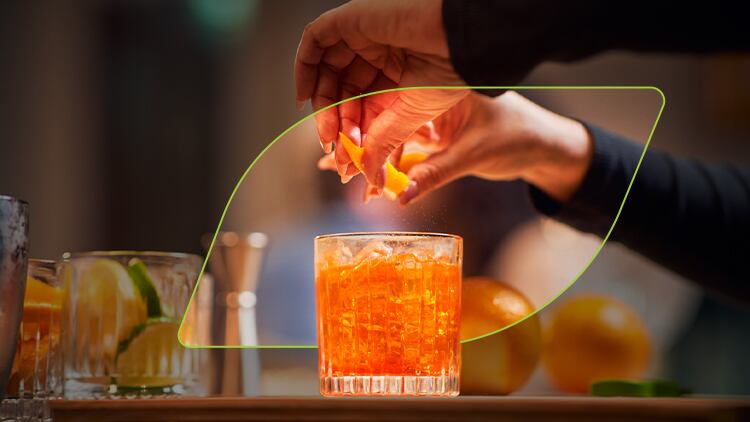Citrus flavors are providing an answer to consumer demands for clean label and natural foods and beverages, thanks to new and authentic flavors.
A huge variety of brands are driving product growth by taking tangy citrus and other fruit flavors that go well beyond the traditional lemon, orange and lime. ADM’s decision to expand its fruit flavors portfolio has created a range of ingredients and expertise that help customers to develop these new products.
Consumer interest in citrus is underpinned by some of the biggest, most sustainable trends in the food and beverage industry. Decades of research into the benefits of citrus, coupled to public health campaigns to increase consumption, have left consumers with positive perceptions of the fruits.1,2 That legacy, coupled to the fact the fruits are natural, makes citrus a good fit for today’s trends.

Those existing trends were given fresh impetus by COVID-19. ADM OutsideVoice research found around one-third of people are buying more health and nutrition products due to concerns related to the pandemic.5 Citrus products are benefiting from the trend. US sales of orange juice rose 51% as the coronavirus spread across the country in the March and April of 2020.6
The ability for citrus ingredients to provide products with a “health halo” is one explanation for why around one-third of flavored beverages introduced over the past three years featured a citrus taste. The ability for citrus ingredients to address consumer demands for new, authentic and fresh flavors is another factor.

Four-fifths of people say they “actively seek out flavors to try on a regular basis” or “like trying new flavors from time to time.”7 Citrus fruits such as pink grapefruit, yuzu, mandarin, pomelo, kumquat and kaffir lime, used alone or in combination, are enabling brands to meet those demands. While Mintel found orange and lemon trended down from 2018 to 2019, launches of products containing ingredients such as yuzu are growing more than 20%.8
When deploying such ingredients, formulators can deliver flavors that are more sour, complex and truer to the taste of the raw fruit than would have been appealing in the past. In 2020, Mintel found consumer preferences for “fresher” fruit flavors, rather than overt sweetness, contributed to citrus being the preferred flavor in non-alcoholic beverages. “Sour” is a recurring entry on annual analyses of the top flavor trends.9,10
Yet, working with citrus also poses challenges to food and beverage brands. The diverse, global range of citrus fruits demanded by consumers pose sourcing, extraction and formulation challenges. Yuzu fruits, for example, yield small quantities of juice. Other fruits lack flavor intensity when formulated into foods and beverages. Volatility in the prices of raw materials is another challenge.
Food and beverage brands need to address those disparate challenges while moving quickly enough to stay ahead of flavor trends, leading many companies to turn to partners with the scale and citrus expertise needed to serve consumer demands.
Serving the citrus sector
ADM made acquisitions to ensure it has the broad citrus portfolio, vertically integrated supply chain and application expertise needed to serve its customers. The operation spans the whole citrus value chain.
ADM sources its citrus fruits through long-term partnerships with suppliers. Those relationships give ADM a transparent supply chain that delivers the best examples of a plethora of raw materials, including exotic, hard-to-source fruits of a range of different varietals and origins. The relationships also insulate ADM and, by extension its customers, from price volatility and fruit shortages, lessening one of the big commercial challenges of working with citrus.
After sourcing raw materials, ADM applies its own extraction and distillation techniques to get the most out of every piece of fruit, from both a flavor and yield perspective. ADM uses the techniques to create citrus ingredients that give consumers a whole fruit experience and have the stability that brands require.
The supply chain and extraction and distillation techniques give ADM’s formulation team a very large portfolio of citrus ingredients to work with. ADM’s portfolio spans low-, mid- and high-folded oils, full-range fractions, whole-fruit extracts, add-back flavors and special, more stable or soluble product lines based on many citrus fruits of interest to brands and consumers. ADM also uses its natural ingredients as the base for natural-identical flavors to support the full range of customer needs.

By pairing that portfolio with application expertise, ADM is able to work alongside its customers to create citrus-flavored beverages and sugar confectionery such as gums and jellies. ADM’s application experts are focused on delivering products that meet the needs of both their customers and the end consumer.
In doing so, ADM is helping its partners to address multiple major consumer trends and commercial opportunities. Consumers want clean label and natural foods and beverages that deliver new, exotic flavors. Working with ADM, brands can quickly recognize and respond to those demands, positioning them for ongoing growth.
References
1. The Powerful Health Benefits of Citrus Fruits. https://thewholeu.uw.edu/2020/01/22/winter-citrus/ (2020).
2. NHS website. Why 5 A Day? https://www.nhs.uk/live-well/eat-well/why-5-a-day/.
3. International Food Information Council. 2020 FOOD & HEALTH SURVEY.
4. Your Guide to the Clean Label Revolution. https://www.crresearch.com/blog/clean-labels-consumer-concerns.
5. Graybill, S. Citrus’ popularity in beverage continues to expand. Beverage Industry https://www.bevindustry.com/articles/93323-citrus-popularity-in-beverage-continues-to-expand (2020).
6. Consumer Response to OJ During COVID-19 - Citrus Industry Magazine. http://citrusindustry.net/2020/06/12/consumer-response-to-oj-during-covid-19/ (2020).
7. Hensel, K. 2020 FLAVOR FORECAST. Food Technol. 73, 44–+ (2019).
8. Media, C. Flavor trends: Discoveries, sophistication and connections among Innova Market Insights’ latest tips. https://www.foodingredientsfirst.com/news/flavor-trends-discoveries-sophistication-and-connections-among-innova-market-insights-latest-tips.html.
9. Crawford, E. 6 trends to watch in 2016: From hard soda and drinkable food to sour flavors and fat. FoodNavigator-USA (2016).
10. Grebow, J. 2020 Flavor trends for food and beverage. Nutritional Outlook (2019).








